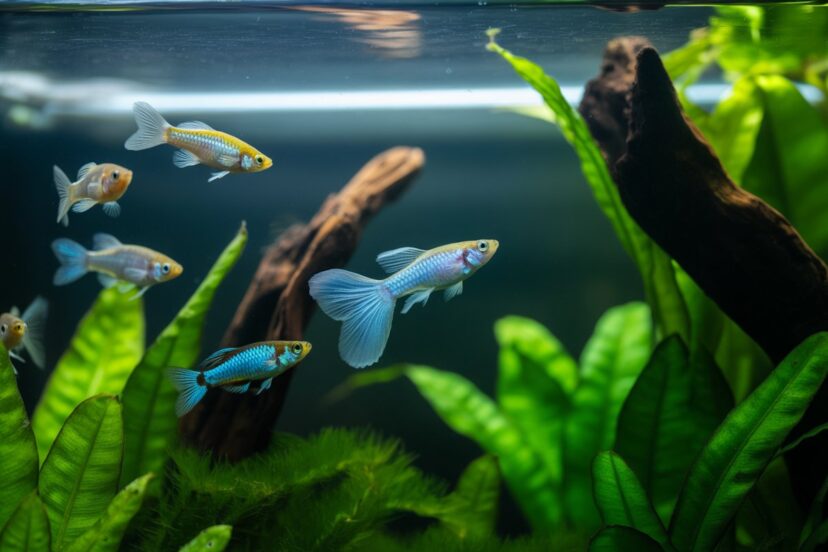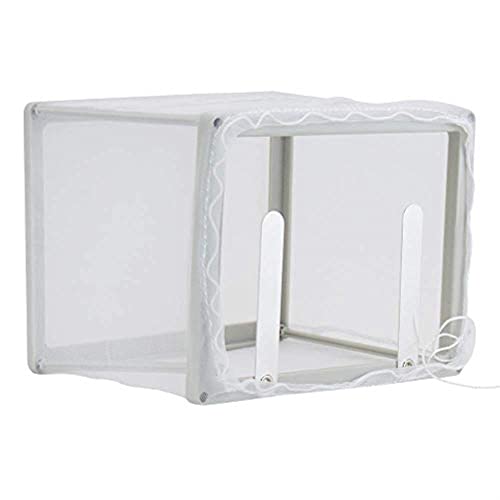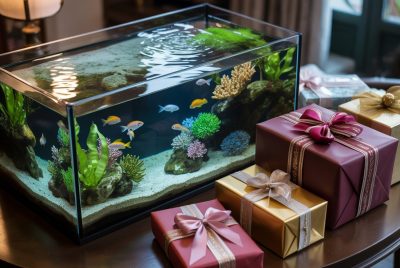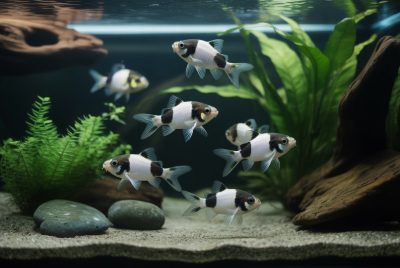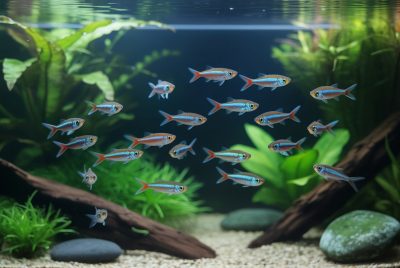The Complete Livebearer Breeding Guide
*We may earn a commission for purchases made using our links. Please see our disclosure to learn more.
The gentle hum of the aquarium filter was the only sound in my living room at 2 AM when I witnessed something magical – my first successful livebearer birth. After months of failed attempts, watching those tiny guppy fry emerge felt like witnessing a miracle. The frustration of previous losses, the countless hours of research, and the worry that I’d never get it right suddenly melted away as these perfect miniature fish swam freely in their nursery tank.
That moment transformed my approach to fishkeeping forever. What started as a casual hobby became a passionate journey into the intricate world of livebearer breeding. It inspired me to create this livebearer breeding guide – not just to document my experience, but to help others achieve the same joy and success. The sense of accomplishment wasn’t just about successful reproduction – it was about creating life, nurturing it, and understanding the delicate balance required to maintain healthy breeding populations.
“The key to successful livebearer breeding lies not in expensive equipment, but in understanding the natural behaviors and requirements of these remarkable fish.”
– Advanced Aquaculture Journal, 2024
Key Takeaways
- Water quality is paramount – Consistent pH, temperature, and ammonia levels determine breeding success
- Proper nutrition enhances breeding frequency and fry survival rates
- Breeding ratios matter – Maintain 1 male to 2-3 females to reduce stress
- Separate breeding tanks increase fry survival by 80-90%
- Patience is essential – Most livebearers reach breeding maturity at 3-4 months
- Regular monitoring prevents diseases that can devastate breeding populations
Recommended Products
1. Fluval Spec V Aquarium Kit (5-gallon)
The Fluval Spec V Aquarium Kit is a sleek, contemporary 5-gallon glass tank that offers both function and flair—perfect for providing your betta fish with a safe and healthy environment. Featuring an etched-glass design with sturdy aluminum trim, it includes a powerful 37 LED lighting system that beautifully illuminates your aquatic setup. Ideal for indoor use, the kit also comes equipped with a 3-stage filtration system (foam block, activated carbon, and BioMax bio rings), ensuring crystal-clear water and optimal conditions for your betta. Its compact size and elegant design make it a top choice for desktops, countertops, or small spaces.
- Design: Sleek, modern aesthetic with quality materials ideal for home or office.
- Filtration: Built-in 3-stage filter keeps water clean and safe for bettas.
- Lighting: Bright 37 LED light enhances visibility and highlights betta colors.
- Flow Strength: Stock pump flow may be too strong for some bettas without modification.
- Heater Not Included: Requires separate purchase to maintain proper water temperature.
- Price: Higher cost compared to basic betta tanks on the market.
This compact aquarium is designed with small livebearer colonies in mind—making it an excellent addition to any livebearer breeding guide setup. It features a built-in LED lighting system to mimic natural day/night cycles and an efficient filtration unit that ensures optimal water quality throughout breeding and fry development. Whether you’re raising guppies, mollies, or swordtails, this tank provides a stable environment that supports healthy reproduction and fry survival.
2. API Master Test Kit
The API Freshwater Master Test Kit is a comprehensive and trusted solution for monitoring the health of your freshwater aquarium. With the ability to perform up to 800 tests, this kit includes everything you need: 7 bottles of testing solutions, 4 test tubes with caps, and a detailed color chart for accurate readings. It measures five critical water parameters—pH, high-range pH, ammonia, nitrite, and nitrate—ensuring your betta fish lives in clean, safe, and stable water conditions. Regular use of this kit helps prevent invisible water issues that can lead to stress, disease, or even loss of your fish.
- Comprehensive Testing: Covers all essential water parameters for freshwater tanks.
- Long-Lasting Value: Provides up to 800 tests, making it cost-effective over time.
- Accurate Results: Trusted by hobbyists and professionals for precise water readings.
- Manual Process: Requires measuring and comparing to color charts, which can be time-consuming.
- Storage Space: Comes in a relatively bulky box that may take up tank cabinet space.
- No Digital Display: Lacks digital convenience some modern testers offer.
This comprehensive test kit is a must-have for any serious aquarist following a livebearer breeding guide. It accurately measures pH, ammonia, nitrite, and nitrate levels—critical factors in maintaining a safe and healthy environment for breeding. Proper water quality management is key to preventing stress, disease, and fry loss, making this kit an indispensable tool in your livebearer breeding setup.
3. Hikari Bio-Pure Freeze Dried Brine Shrimp
Support healthy breeding and fry development with Hikari Bio-Pure Freeze Dried Brine Shrimp, a top pick for livebearer enthusiasts. Packed with protein and natural nutrients, this shrimp-based food enhances color, boosts vitality, and encourages breeding behavior. Ideal for all life stages, it’s a must-have supplement in any livebearer breeding guide.
- Nutrient-Rich: High in protein and essential fatty acids for fry growth and adult vitality.
- Safe and Convenient: Freeze-dried to eliminate parasites without losing nutritional value.
- Breeding Support: Helps stimulate natural breeding instincts in livebearers.
- Can Cloud Water: Overfeeding may cause temporary water cloudiness.
- Not a Complete Diet: Best used as a supplement, not a standalone food.
- Small Quantity: 0.42 oz may not last long for larger tanks or multiple fish.
This high-protein formula is a valuable addition to any livebearer breeding guide, enhancing breeding conditioning in adult livebearers and supporting the healthy development of growing fry. Packed with essential nutrients, it promotes vibrant coloration, increased energy, and higher fry survival rates—making it ideal for guppies, mollies, platies, and swordtails during breeding cycles.
4. Marina Breeding Box
The Marina Fish Net Breeder is a practical and affordable tool for any aquarist following a livebearer breeding guide. Designed with fine mesh and a secure floating frame, it provides a safe space for pregnant fish to give birth and for fry to grow away from potential threats. Easy to use and install, this breeding box is ideal for guppies, mollies, and other livebearers.
- Gentle Protection: Fine mesh keeps newborn fry safe from adult fish.
- Floating Design: Stays securely in place with no complex installation.
- Affordable Solution: A budget-friendly breeding box for beginners.
- Limited Space: Best suited for small batches of fry.
- Can Tilt Slightly: May shift if not properly secured in the tank.
- Mesh Cleaning Required: Mesh may clog with debris if not cleaned regularly.
A must-have tool in any livebearer breeding guide, this adjustable breeding box safely separates pregnant females and protects newborn fry from being eaten. Its versatile design fits most aquarium setups and works perfectly for common livebearer species like guppies, mollies, and platies. Ensuring a stress-free birthing environment, it increases fry survival and supports successful breeding outcomes.
My Journey into Livebearer Breeding
My fascination with livebearers began during a routine visit to the local fish store. While other customers gravitated toward exotic saltwater specimens, I found myself mesmerized by a tank of colorful guppies. Their vibrant tails, active personalities, and the store owner’s casual mention that “they breed like crazy” sparked something in me.
The initial months were humbling. Despite their reputation for easy breeding, I watched fish after fish fail to reproduce successfully. The females would become gravid (pregnant), showing the telltale dark gravid spot, but the fry either disappeared immediately or never appeared at all. The emotional roller coaster of anticipation followed by disappointment taught me that successful breeding required far more than simply putting males and females together.
My breakthrough came when I shifted focus from forcing reproduction to creating optimal conditions. Instead of overcrowding community tanks, I established dedicated breeding setups. The transformation was remarkable—within weeks, I had thriving populations of guppies, mollies, and platies. That experience became the foundation of this livebearer breeding guide, built not just on success, but on trial, error, and learning what truly works.
Understanding Livebearer Biology
The Miracle of Live Birth
Unlike egg-laying fish, livebearers give birth to fully-formed, free-swimming fry. This reproductive strategy, called ovoviviparity, means females carry developing embryos internally for 21-35 days depending on species and environmental conditions. The pregnant female’s belly becomes noticeably swollen, and the gravid spot near the anal fin darkens as birth approaches.
During my early breeding attempts, I didn’t realize how stress affects gestation. Pregnant females in overcrowded or unstable environments often reabsorb their young or give birth prematurely to underdeveloped fry. Learning to recognize and minimize stress factors became crucial to my success.
Species-Specific Considerations
Guppies remain the most popular choice for beginners. They’re incredibly prolific, with females producing 20-40 fry every 28 days under optimal conditions. Their tolerance for varying water parameters makes them forgiving for new breeders.
Mollies require slightly different care, preferring harder water with some salt content. They produce larger broods (20-60 fry) but need more space due to their size. Sailfin mollies, in particular, benefit from larger breeding tanks.
Platies and Swordtails fall somewhere between guppies and mollies in care requirements. They’re peaceful, colorful, and produce moderate-sized broods of 10-30 fry. Their calm temperament makes them excellent community breeding fish.
Creating the Perfect Breeding Environment
Water Quality: The Foundation of Success
The turning point in my breeding journey came when I invested in proper water testing equipment. Maintaining consistent parameters proved more important than achieving “perfect” numbers. Livebearers thrive in slightly alkaline water (pH 7.0–8.0) with moderate hardness.
Temperature stability matters enormously. I learned this lesson when a faulty heater caused temperature fluctuations that resulted in birth complications and fry deformities. Now I maintain breeding tanks at a steady 76–78°F (24–26°C) using reliable heaters with backup thermostats.
Filtration requires careful balance. Adequate biological filtration prevents ammonia spikes that can kill fry, but excessive water movement stresses pregnant females and can suck up newborns. I use sponge filters or adjust intake tubes with pre-filter sponges to create gentle water flow.
If you’re following a livebearer breeding guide, prioritizing water quality is essential—it’s the cornerstone of healthy reproduction, fry survival, and long-term colony success.
Tank Setup and Design
My most successful breeding setup consists of 10-20 gallon tanks with dense live plant coverage. Java moss, hornwort, and floating plants like water sprite provide essential hiding places for fry while maintaining water quality through natural filtration.
The substrate choice surprised me with its importance. I initially used bright gravel that made the fish nervous and colors appear washed out. Switching to darker substrates helped fish display natural behaviors and enhanced their coloration, leading to more successful breeding displays.
Lighting affects breeding behavior significantly. I provide 10-12 hours of moderate lighting daily, mimicking natural daylight cycles. Too much light stresses fish, while insufficient light reduces breeding activity and plant growth.
Nutrition: Fueling Reproduction
Proper nutrition transformed my breeding success rate more than any other single factor. Conditioning adults with high-quality foods for 2-3 weeks before breeding significantly increases fry production and survival rates.
Adult Breeding Diet
I feed breeding adults small amounts 2-3 times daily, focusing on protein-rich foods. High-quality flakes form the base diet, supplemented with frozen bloodworms, brine shrimp, and occasional live foods. The increased protein content supports egg development in females and enhances male coloration and vigor.
Variety prevents nutritional deficiencies that can cause birth defects or weak fry. I rotate between different protein sources and include vegetable matter like blanched peas or spirulina-based foods, especially important for mollies and other herbivorous species.
Fry Nutrition Strategy
Newborn livebearer fry are large enough to eat crushed flakes immediately, unlike many fish species that require microscopic foods. However, specialized fry foods provide better nutrition for rapid growth. I use powdered fry food for the first week, gradually introducing larger particle sizes.
Live baby brine shrimp accelerate growth remarkably but require preparation and maintenance. For convenience, I often use high-quality powdered foods supplemented with liquid fry food, achieving excellent growth rates with less effort.
Breeding Management Techniques
Population Control and Genetics
Selective breeding became an unexpected passion as I learned to identify desirable traits and breeding potential. Maintaining detailed records of parentage, birth dates, and notable characteristics helped improve my lines over multiple generations.
If you’re following a livebearer breeding guide, genetics and population control are essential components. Preventing inbreeding requires careful management in small breeding populations. I rotate breeding stock regularly and maintain separate lines to preserve genetic diversity. The emotional attachment to particular fish sometimes made culling difficult, but maintaining healthy populations required tough decisions.
Timing and Breeding Cycles
Understanding natural breeding rhythms improved my success dramatically. Female livebearers can store sperm for multiple pregnancies, meaning a single mating can result in several broods. This biological fact initially confused me when isolated females continued producing fry months after separation from males.
I learned to recognize pre-birth behaviors that signal imminent delivery. Females become reclusive, seeking secluded areas or hanging near the surface. Their movements become more deliberate, and they may refuse food for 24-48 hours before giving birth.
Common Challenges and Solutions
Fry Survival Issues
My biggest frustration involved watching fry disappear despite seemingly perfect conditions. Adult fish, including the parents, readily consume newborns if given opportunity. This natural behavior initially shocked me, but understanding it as normal helped me develop effective management strategies.
Breeding boxes provide temporary solutions but stress pregnant females if used too long. I prefer heavily planted tanks where fry can hide naturally, supplemented by floating breeding traps only during actual birth events.
Overcrowding kills more fry than predation in my experience. Maintaining appropriate stocking densities and providing adequate filtration prevents the water quality issues that devastate young fish populations.
Disease Prevention
Disease outbreaks devastated my early breeding attempts before I understood prevention principles. Quarantining new fish, maintaining stable water conditions, and avoiding overfeeding dramatically reduced disease incidents in my breeding colonies.
Any thorough livebearer breeding guide should emphasize the role of stress in disease susceptibility. Stress weakens immune systems, making fish more vulnerable to opportunistic infections. I learned to identify and eliminate stress factors: aggressive tank mates, poor water quality, inadequate hiding places, and sudden environmental changes. By prioritizing fish health and stability, I created a safer, more resilient breeding environment.
Breeding Ratio Management
Male livebearers can be persistent in their breeding attempts, stressing females if ratios are incorrect. Maintaining 1 male to 2-3 females distributes attention and reduces individual female stress. In heavily planted tanks, slightly higher male ratios work because territories are established.
The Broader Impact of Breeding Success
Successfully breeding livebearers affected my entire approach to fishkeeping. The attention to detail required for breeding success improved all my aquarium maintenance practices. Water testing became routine rather than reactive, feeding schedules became consistent, and I developed better observation skills for detecting problems early.
The sense of responsibility for creating life changed my perspective on fish welfare. These weren’t just decorative objects but living creatures dependent on my care for their survival and well-being. This shift in mindset made me a more thoughtful and successful aquarist overall.
Sharing surplus fish with other hobbyists created connections within the local aquarium community. Trading fish, sharing experiences, and collaborating on breeding projects enriched my hobby experience beyond the solitary activity it began as.
Advanced Breeding Techniques
Line Breeding for Specific Traits
As my confidence grew, I began focusing on specific characteristics: enhanced coloration, fin development, or size. Line breeding requires patience and detailed record-keeping but produces remarkable results over multiple generations.
Color enhancement through selective breeding became particularly rewarding. Starting with basic colored fish and gradually intensifying desired traits through careful selection created stunning specimens that rival commercial varieties.
Environmental Breeding Triggers
Manipulating environmental conditions can encourage breeding in reluctant pairs. Slightly increasing temperature, performing large water changes, or adjusting lighting schedules often triggers breeding behavior in conditioned adults.
Barometric pressure changes affect breeding behavior, with many breeders reporting increased activity before weather fronts. While I can’t control weather, understanding these natural triggers helps me recognize optimal breeding periods.
Seasonal Considerations for 2025
Climate control becomes crucial during extreme weather periods. Summer heat waves require backup cooling systems, while winter heating failures can devastate breeding populations. Planning for seasonal challenges protects years of breeding work.
Seasonal availability of live foods affects conditioning programs. I plan breeding cycles around times when high-quality foods are readily available, typically spring and fall when live food cultures are most productive.
Building Your Breeding Program
Starting Small and Scaling Up
Begin with a single species and master their requirements before expanding to multiple types. My early attempts to breed several species simultaneously resulted in mediocre success across all varieties rather than excellence with any.
Document everything from the beginning. Breeding records, feeding schedules, water parameters, and birth dates create valuable data for improving techniques and tracking genetic lines.
Equipment Investment Strategy
Quality equipment costs more initially but pays dividends through reduced failures and maintenance time. Reliable heaters, efficient filters, and accurate test equipment prevent the disasters that destroy months of breeding progress.
Start with essential equipment and upgrade gradually. A basic setup that functions reliably beats expensive equipment that’s improperly maintained or understood.
The Emotional Journey of Breeding
Celebrating Small Victories
My first successful birth felt more rewarding than any expensive fish purchase. The pride in creating and nurturing life provided satisfaction that purchasing adult fish never matched. Learning to celebrate these milestones sustained motivation through inevitable setbacks.
Each generation improvement, whether increased fry survival or enhanced coloration, represents success worth acknowledging. These incremental improvements build toward long-term breeding goals.
Learning from Failures
Failed breeding attempts taught more valuable lessons than easy successes. Analyzing what went wrong, adjusting techniques, and trying again built the experience necessary for consistent results.
The emotional investment in breeding fish makes losses particularly difficult. Learning to view setbacks as learning opportunities rather than personal failures maintained my enthusiasm through challenging periods.
Future Aspirations and Continuous Learning
My breeding journey continues evolving as I explore new species, refine techniques, and set more ambitious goals. The hobby’s depth ensures there’s always something new to learn or improve.
Connecting with other breeders through online forums and local clubs provides ongoing education and inspiration. Sharing experiences and learning from others’ successes and failures accelerates personal improvement.
Conclusion
The journey from frustrated beginner to successful livebearer breeder transformed not just my fishkeeping skills but my entire approach to nurturing life. The lessons learned through countless hours of observation, trial and error, and gradual improvement extend far beyond the aquarium.
Every successful birth, every healthy fry that reaches maturity, and every improved generation represents a small victory in understanding and working with nature rather than against it. The patience required, attention to detail demanded, and responsibility accepted in breeding livebearers develops character traits valuable in all life areas.
Your own livebearer breeding journey awaits, filled with the same challenges, discoveries, and rewards that made my experience so transformative. Start with quality fish, maintain excellent water conditions, provide proper nutrition, and above all, remain patient and observant. The moment when you witness your first successful birth will make every effort worthwhile.
The underwater world of livebearers offers endless opportunities for learning, improvement, and the deep satisfaction that comes from successfully nurturing life. Whether you’re drawn to the vibrant colors of guppies, the graceful fins of mollies, or the peaceful nature of platies, the principles remain consistent: respect the fish, understand their needs, and create conditions where they can thrive naturally.
Your breeding program represents a living legacy that can benefit the hobby community for generations. The fish you breed today may become the foundation stock for future breeders, continuing the cycle of learning and improvement that makes this hobby so rewarding.
Frequently Asked Questions
How long does it take for livebearers to reach breeding age?
Most livebearer species reach sexual maturity at 3-4 months of age, though this varies with species, water temperature, and nutrition quality. Guppies typically mature fastest, while larger species like mollies may take up to 6 months to reach full breeding potential.
Can different livebearer species breed together?
While some closely related species can hybridize (like guppies and endlers, or certain molly varieties), most livebearer species cannot successfully interbreed. Cross-species breeding often results in sterile offspring or developmental problems, so it’s best to maintain pure species lines.
How many fry do livebearers typically produce?
Fry production varies significantly by species and individual fish. Guppies typically produce 20-40 fry per birth, mollies can have 20-60, while platies and swordtails usually produce 10-30 fry. Larger, older females generally produce more offspring than younger, smaller ones.
What’s the best way to separate pregnant females?
Breeding boxes work for short-term separation during actual birth, but heavily planted tanks with dense vegetation provide the most natural environment. If using breeding boxes, limit confinement to 24-48 hours around birth time to minimize stress on the female.
How can I tell if my female livebearer is about to give birth?
Signs of imminent birth include: darkening of the gravid spot, squared-off belly appearance, reclusive behavior, hanging near the surface or hiding in plants, and refusing food for 24-48 hours. Some females also display restless swimming patterns or apparent “contractions.”

